A Review by Bullet.
I’ve had my Farley for a month now and have put about 150 miles on it in just about every imaginable trail condition. I feel I am ready to deliver a competent, informed review. Let’s start with the easy stuff.
Cosmetics and Style
I’m not crazy about a black paint job on my bikes. I feel it likes to show the inevitable scrapes, dings, and general wear that is inevitable on an off-road machine. That being said, I think Trek has done a nice job pairing it with the anodized green components and logo. The bright green touches give the Farley a bit of flare without being obnoxious
It’s too bad Trek couldn’t come up with some green rim strips to make the wheels pop and tie everything together. I’ve looked and there aren’t any to be found, so, after picking up some cactus needles in my front tire during a ride, I bought some lime green Duck Tape and took care of the rim strips myself.
Frame and Fit
The 15.5” frame is where I was most impressed and let down at the same time. As I mentioned in my first impressions post, I have a body type that is not easy to fit. The Farley fits me perfectly. I’ve never been able to pull a bike off the rack and just ride it without feeling cramped in the cockpit. I feel like this bike was made for me. Trek’s Alpha Platinum aluminum frame set is very light, stiff, and beautifully sculpted. The top tube is ovalized at the seat tube to stiffen the frame at the crank to direct more power to the rear wheel. The E2 tapered head tube again adds stiffness to the front end and delivers very precise and responsive steering. The internally routed derailleur cables are a must on a fat bike and Trek did not disappoint there either; they even have the frame set up for internal routing if you add a dropper seat post. It would seem that they thought of everything. Almost.
The Farley is a new breed of fat bike. It is a bike that leans toward the performance end of the scale rather than the traditional backcountry touring and general exploring kind of bike. Trek did put mounts on the rear for a rack and a single mount on either side of the fork for front racks and panniers, so the touring option is there. Barley. Please keep in mind that my situation with a 15.5” frame is a little different than it would be with a larger frame.
Here are my issues:
I have one bottle cage mount in the standard place on the down tube. Not unusual for the frame size. I would really like the option of another mount under the down tube, as well as cage mounts on the front fork like some of the Salsa and Surly models have. These features would not add much weight and would give more options for those of us who plan to do a bit of backcountry touring. As it is now, if I add a frame bag my only option for carrying water is on my back. I was really hoping to go with a lighter pannier-type system on the forks using a pair of Salsa Anything Cages and dry bags. I realize there are a lot of other options out there when it comes to rigging your fat bike for touring but some of the simplest options have been removed due to the lack of mounts that I feel would have been easy to add without taking away from the the Farley’s svelte look.
The Bontrager Race Lite Low Rise bars have a nice feel and at nearly 29” wide give the rider a nice stable platform to pilot the Farley. Initially I really liked the Bontrager Race Lite lock-on grips. They are very low profile and felt nice with my smaller hands. As I spent more time on the bike, especially on longer rides, I found them to be a bit lacking in the comfort department. The Farley has a bit of a stiff ride and I found my hands would get a little tired toward the end of a particularly rough or long ride. This will be an item that will get replaced with something a little more cush but not too soft. The Race Lite is not a bad grip, just not ideal for me.
The Bontrager Evoke 2 saddle with the green accents is great. I am used to riding a Selle Italia Flight titanium saddle and found the Evoke 2 to have a similar feel. I’ve never had a hint of saddle soreness under any conditions on the Farley. That’s saying something. Usually a new saddle takes a little getting used to.
Wheels and Tires
The Farley comes standard with the 82m Surly Holy Roling Darryl rimes, 135mm Salsa alloy front hub, 170mm hub on the rear and Surly Knard 120 tpi 26X3.8 tires. I like the wider rim with the narrower 3.8 tires. I feel this combination maximizes the patch of tread that contacts the trail rather than a wider tire on a narrower rim. There is much debate out there on fat bike tires, I have ridden the Farley with this tire and wheel combination on single track, gravel roads, desert slickrock, sloppy mud, and 4-6” of new snow. I feel I have a pretty good understanding of what the Knard tire excels in and where it falls short. You also need to understand that this is my opinion based on my experience with them and my riding style.
I found that for most of the riding I have done, and probably will be doing on the Farley, the Knards are a very nice handling tire with excellent traction. I coach a high school mountain bike team, so much of my riding has been on single track with some fairly technical climbing though loose rick. The Knards do not disappoint. They roll smoothly and grip everything. I was constantly amazed at what I could climb up and over with relative ease. They also had good float and traction when it got muddy and slick. They weren’t impervious to slipping in certain muddy situations, but they were no worse than others riding the Surly Nate tires. On slickrock and climbing over rock steps they could not have been better. I think the Knard would be a great option for summer touring and general trail riding.
I was able to get about 14 miles or so in the snow as well. We rode a single track trail and had to ride through 4-6” of new snow. We were riding in a group and I found the tires to grip well when I was toward the back of the group riding on the freshly packed trail. Breaking trail was a little different. Traction wasn’t terrible, but did seem a bit lacking compared to the Nate tires that most everyone else was riding.
A few more snow rides in various conditions will give me a better opinion on the Knards’ snow performance. For now I would say they are a great solution for just about any riding conditions. Although they weren’t terrible, I think there are probably better options for the snow.
Drivetrain and Brakes
I could not be happier with the Sram X9 2X10 drivetrain. It is smooth, precise, and fast. Even when the rear sprocket looked like a snow cone, it shifted without hesitation. I have been regularly surprised how quick and effortlessly the front derailleur shifts under pressure. You know those times when you come around a corner in a tall gear to find an abrupt climb in your face and you hit the shifter but it won’t go because you are already cranking the pedals up the hill. You know what I’m talking about. The X9 system would drop smoothly allowing to me breeze up the hill (most of the time). Again this is an area where Trek did their homework. The gearing is excellent with a 36/22 on the front and 11/36 on the rear. I’m not sure I could have done any better job had I hand selected the gearing myself.
The Avid DB3 hydraulic brakes have been very nice and I expect them to run flawlessly for a long time to come. One thing I did notice during our snow ride was the brake noise everyone was experiencing because of the wet conditions. My DB3’s were noticeably quieter than the others on the trail that day. Only once at the beginning of the ride, and occasionally when braking hard, did they even attempt to make a howling. Maybe I have less miles on my brakes, or maybe there is something about them that is just a little nicer. Either way, I am happy with them.
The Final Word
As I mentioned earlier, the Farley is one of a new breed of fat bike that is more performance-oriented than traditional fat bike offerings. Trek has tried to hold on to some of the traditional features like the rack mounts, but in large part it is designed for faster trail riding rather than touring. The ride is much stiffer than that of the new Mukluk or Pugsley, due in large part to a tapered head tube and aluminum fork. There is a trade off there. Stiffer can be a bit tiring on a long ride but really pays off in how it handles in the corners. My 15.5” Farley weighed in at just over 31 lbs. so it is pretty light in the fat bike world. All these things combined with the geometry make the Farely an incredibly fun bike to ride in every condition. It is responsive and quick on technical trails and climbs like a mountain goat. The only thing holding it back on the climbs, regardless of how loose or rough or steep, is me.
The Farley does not feel like a fat bike under you. It feels light and quick. It eats up the trail regardless of the conditions. The green anodized Race Face cranks and Salsa hubs give the Farley a custom built feel that you don’t normally get with a production bike. At an MSRP of $2,600 I think Trek has introduced a bike that delivers a lot of value in a sleek package. The unfortunate part of the story is that Trek oversold the Farley 4 to 1, which means that most dealers that ordered them will not be getting any. I believe the slowed production from Trek is due to a lack of supply from Surly for their wheels. No surprise there. With the surge in fat bike manufacturers wanting to use Surly wheels, they can’t keep up with demand. Maybe next year we will see a Bontrager fat wheel set and tires. I know Farley frame sets are available. I think that would be a great platform to start a custom build.

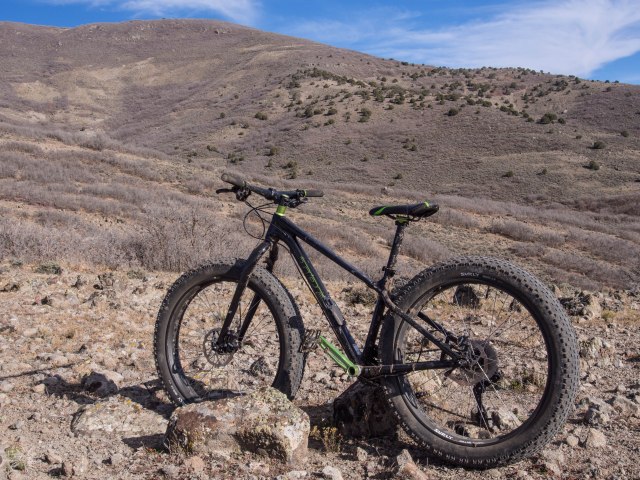
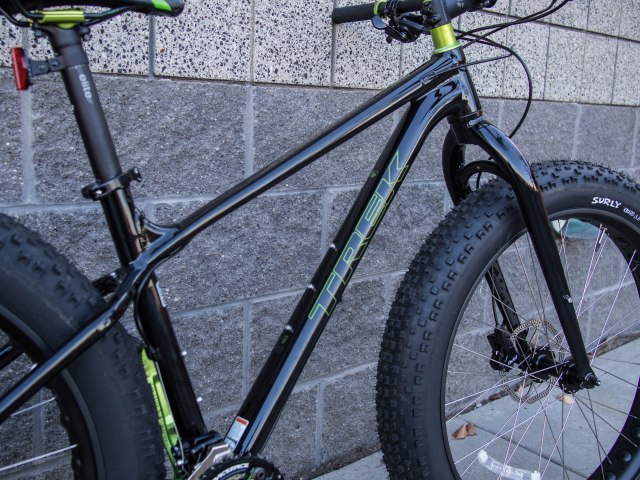
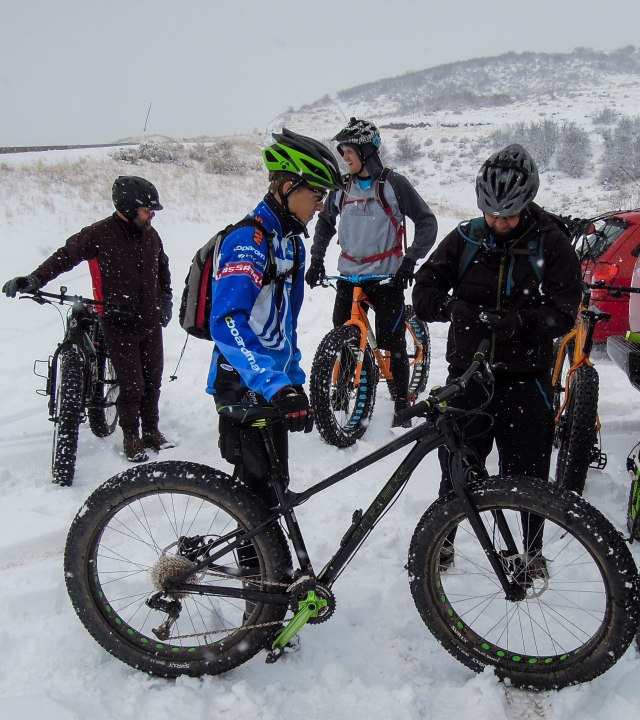


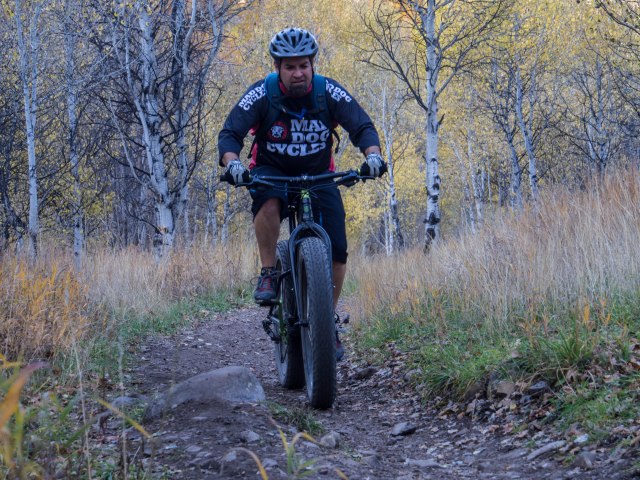
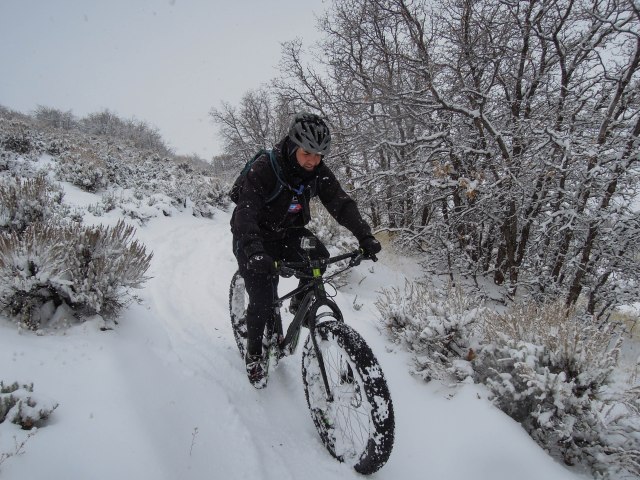
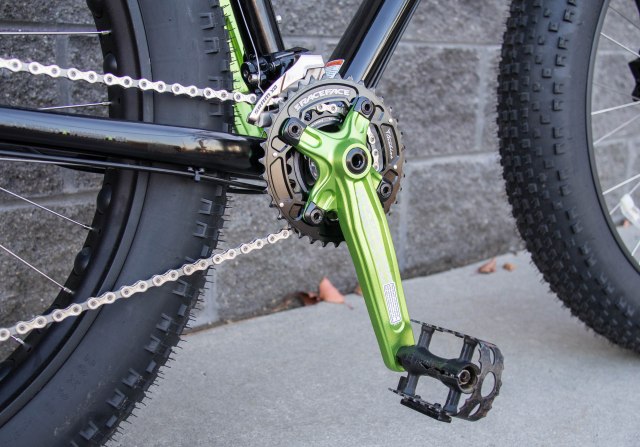
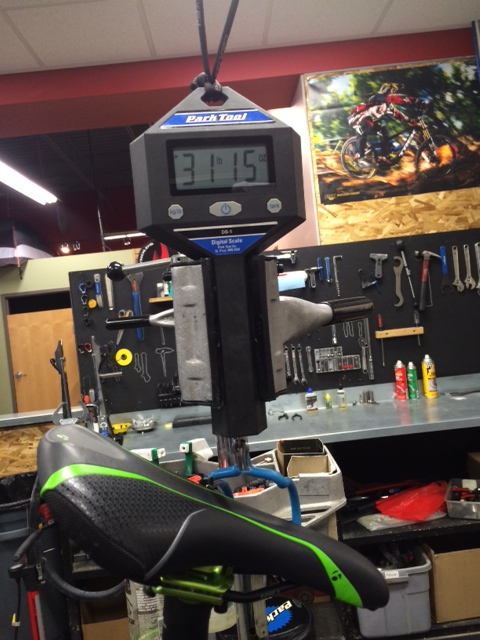
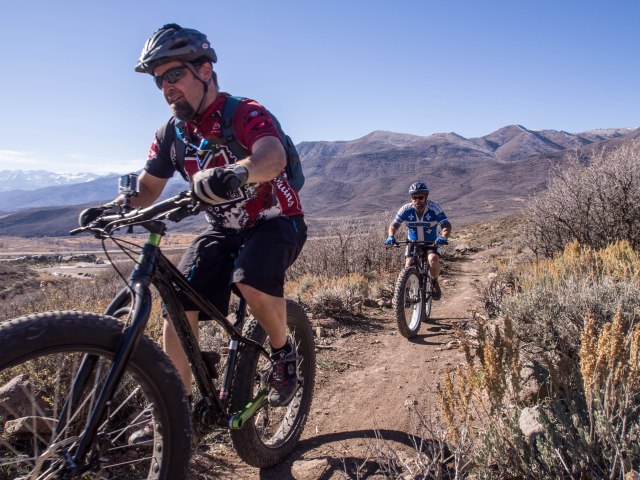
That bike looks like a keeper to me!
I am begging you…PLEASE proofread your posts, or get an editor and check your content before posting. It is agonizing reading dozens of mistakes in one article! You are trying to write reviews and deliver a blog which is a form of journalism. Please do the work to make the writing as professional as any other component of your blog. No one could take you seriously with the overwhelming number of errors and typos. There are a million spell-check programs out there…please use one!
Thanks to you, I drove from Florida to the Madison Wisconsin Trek store last weekend for my Farley. Could not find it anywhere, and they wouldn’t ship. Rode it today for the first time, UNBELIEVABLE!!!! Well worth the drive (2800 miles!!) Wish I could ride with you guys up there, looks like fun.
Congratulations Mike. Man, that’s pretty hardcore to drive that far to get your bike. Glad we could help and glad you like the bike.
Enjoy it. Look us up if you’re ever in Utah. We can show you some great trails.
Will do.
How tall are you? You said, “The 15.5” frame is where I was most impressed and let down at the same time”, in regards to frame and fit. You didn’t really ellaborate on what you were “let down” with. Is it just the fact that it only has one water bottle mount in that size. I’m 5’6″ and have an opportunity to pick up a 17.5″ Farley. Currenty ride a 16″ Pugs.
I am 5’7″ (on a good day). My inseam is 28″ and I’m a bit long int he torso so finding a bike that fits me off the rack is not easy. That is where the Farley really was great for me. It fits me great without changing anything. The disappointment was in the lack of water bottle cages. I’m used to one bottle mount on mountain bike frames in my size but I thought with a fat bike I’d get lucky with some on the fork and maybe on the bottom of the down tube. Really not a big deal but in doing an honest review of the bike I had to mention what I didn’t like about it.
My girlfriend is 5’6-7″ with a 30ish inseam and loves her 17.5″ frame. The top tube is only 23.2, wo the reach for her was perfect. She had a harder time fittling the salsa/surlys.
Hey, great write up on the Farley! I liked the video too. My LBS ordered mine today (a 19.5″). I was just curious; do you know how fat you can go with tires on this frame?
The rear end of the Farley is not wide enough to accept a tire wider than the 3.8. It will accept a 3.8 Surley Nate as well as any other 3.8 I’ve seen out there. There is a buzz out there that the Farley rear end is too narrow to accept anything but the Knard but that is simply not true. The front end is a bit wider and will accept something bigger than the standard 3.8 tires. I have not tried anything myself but am considering going to a 4.8 on the front end for next winter. I was talking with a couple of the Trek reps at the Fat Bike Summit here in Ogden in January and it sounds like Trek will have some nice offerings from Bontrager in the wheel and tires market. Hopefully we will have some exciting new stuff to test this year. Enjoy your new Farley. Thanks for following the blog.
i love my farley. i am still new in the “fat world”. tire pressure suggestions?? (sheronrx@aol.com)
I typically run 9 to 10 pounds on dry trails and 5 or less in the snow.
Hi fellas, great review. I saw a 2015 Farley 6 after a ride at my local trail centre here in the uk. its now black with blue accents and looks amazing. comes with sun ringle mulefut rims and Hodag tyres. I was gutted when the 19.5″ frame didn’t fit me (I’m 5’5″ – 5’6″) so they’re getting a 15.5″ for me to try out. With luck I’ll have it by the end of the week ready to take on a beach holiday. Can’t wait.
I want to get the Farley/Fat Bike. But I want to be able to put 4.5+ tires on them. On the trek website, it says the max tire size is 4.0. Do you know if it’s possible to put larger than 4.0 on that bike?
NM, You already answered the question. It’s NO 😦
Just got a new to me 2014 Farley. I live in the south. No snow all single track. Any suggestions for fast tubeless tires for trail conditions? My Nate came with a nice hole in the sidewall. Nate tires are OK. I could climb a tree with them. In loose pine straw I slide when cornering. Are Mission 4.0 s good in dry trails? Will they fit a Farley? Looking for tires to go tubless. I see almost no one on fat bikes here. Got a good deal on used fat bike. Lots of 29+ &650b + lately. I would be thankful for any advice.
Tom